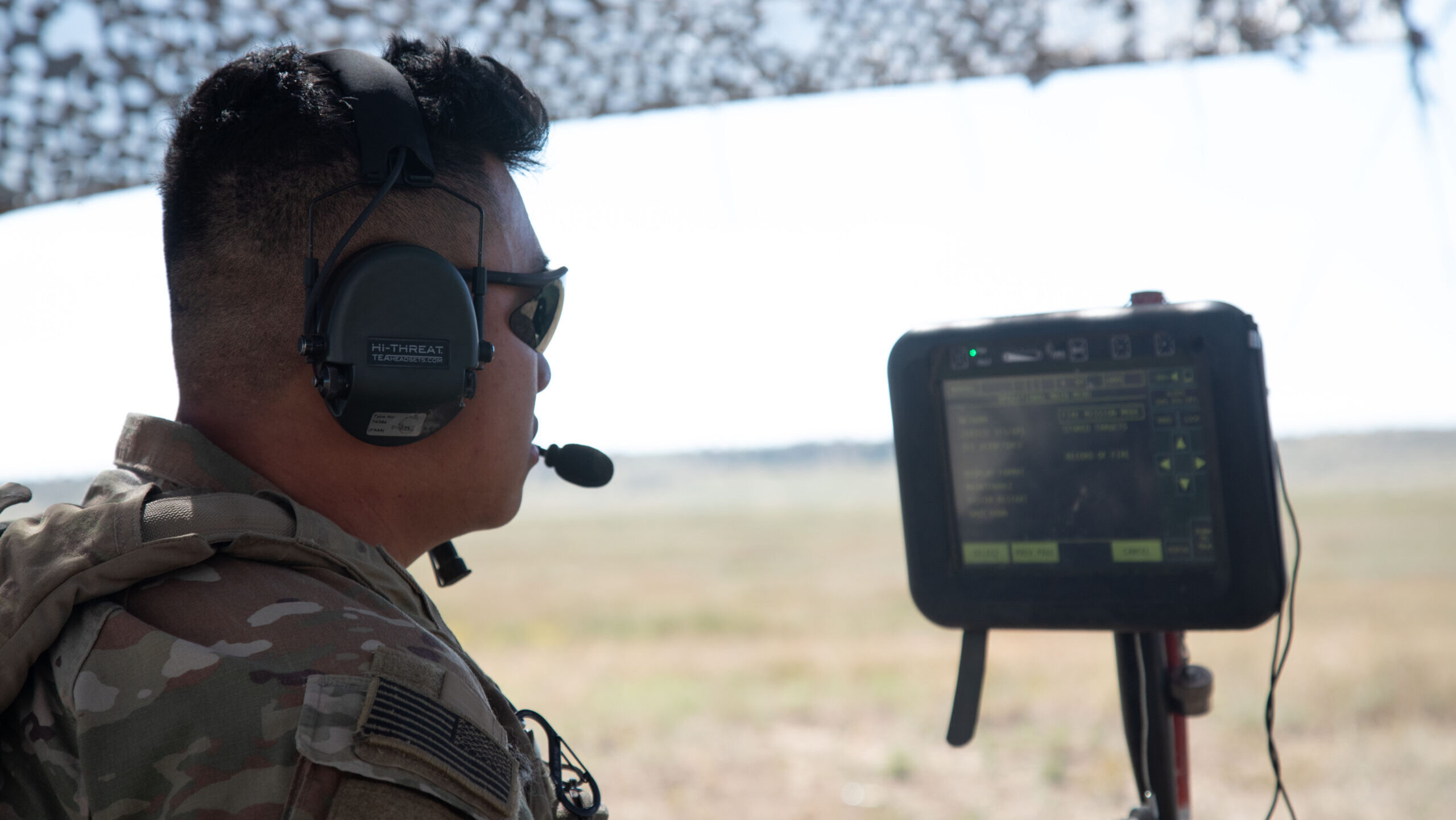
This is part one of a two-part series on the Army’s Ivy Sting events, in which the service is working to scale up the Next Generation Command and Control prototype to the division level.
FORT CARSON, Colo. — The Army unit hadn’t originally planned to fire the M777A2 Howitzer using a new data management tool for the first time ever so soon, but the pieces fell into place, everything was set, so soldiers from the 4th Infantry Division let it rip.
When the smoke cleared from the test strike on Sept. 15, the 4th ID had taken a small but important step toward maturing and expanding the service’s critical Next Generation Command and Control (NGC2) initiative, which aims to use cutting-edge tech to push the 250-year-old organization to the forefront of modern battlefield management.
“That’s the beginning of a new era for the Army,” 4th Infantry Division Commander Maj. Gen. Patrick Ellis told reporters in September, days after the firing.
It was also the first, admittedly narrow use of a new series of test exercises, dubbed Ivy Sting, that aim to rapidly test and evaluate NGC2 tech on a rolling basis as the Army looks to scale the capability to the division level.
In mid-September, a small group of reporters visited the home of the 4th ID at Fort Carson, Colo., to see parts of Ivy Sting 1 firsthand, where the Army used its a beta version of its new Artillery Execution Suite (AXS) tool to speedily gather target information, pass it through the necessary chain and then hit its target.
In the past warfighting functions, such as intelligence, logistics or fires, were siloed in their own staff sections with their own systems slowing down sharing and situational awareness. NGC2 aims to collapse all those systems and functions into applications analogous to an iPhone so a commander or units will have access to all the data and information. AXS will be one of those “apps” within the system.
“There’s not one criteria that says a success or failure [for Ivy Sting 1],” Ellis said on Sept. 17. “Really, we already met the success criteria, which was, we thought today would be the first live fire, but the software was ready, the soldiers were ready, the gun crews were ready. We actually accelerated all this stuff, and we shot live on Monday night.”
Hitting The Mark, Quicker
The Army sees NGC2 as a years-long effort to do a generational upgrade to its command and control regime. The Army awarded Anduril and a team of vendors a nearly $100 million contract to prototype a broader NGC2 system for 4th Infantry Division between July and next summer for Project Convergence Capstone 6. More recently Lockheed Martin and its team of vendors were awarded a contract to work an integrated data layer for 25th Infantry Division under the NGC2 portfolio.
But for the first iteration of Ivy Sting 1, Ellis said fires was a more manageable place to start.
“The fires thread is a very logical thread that we all understand really well. AXS was coming along. We knew was coming online. We accelerated that because fires threads are really good,” he said. “The fires backbone becomes a very convenient place for us to then pull in all of these other threads and say, this is where I need to make all of these other things work.”
Currently, hitting something with a howitzer looks something like this: A target comes across the Army Intel Data Platform and goes to the strike cell, a staff entity within the division that fuses fires and intelligence. That cell vets targets under a very manual process.
Once the target is nominated, it is passed to the Joint Air-Ground Integration Cell (JAGIC), a collection of multiple staff sections that serves as a capability for the division commander. Namely, it manages the airspace and effects for the division commander and select the right asset to strike the nominated target, either through kinetic or non-kinetic means.
If the JAGIC decides that field artillery is the right weapon for the target, that nominated target is then passed to the Fire Control Element, another staff element within the division. The FCE will decide what field artillery unit is best to action that target based on what unit is in the best position and has the most rounds.
The target data is passed to the Fire Direction Cell that will actually fire the M777.
That’s a lot of gates to pass data through, especially in time-sensitive combat operations in which the target might just pick up and leave at any moment. That’s where the targeting piece of the envisioned NGC2 ecosystem comes in — in this case, the AXS beta software — both to speed the entire process and to conduct some analysis on its own to relieve the cognitive burden on the soldiers and staff involved.
There is already a data management tool to help aid the process, known as Advanced Field Artillery Tactical Data System (AFATDS), which provides fully automated support for planning, coordinating and conducting fires — but which entered service in 1995.
Col. Charlie Brown, division artillery commander for 4th ID, said AFATDS has been successful in the “last 20 to 23 years, where it has worked mostly in a static COIN [counter-insurgency] environment.”
But, he said, “What we foresee as a dynamic, multi-domain environment, we don’t think AFATDS can get there. AXS is being introduced to help accelerate that kill chain.”
Reduce Risk, Increase The Tempo
For the exercise, the 4th ID used both AFATDS and AXS to take out one target each, but there was evidence AXS was speedier very early on.
A few days before the official live fire test, when soldiers and officials were doing their checks and dry runs, it took users over two hours of troubleshooting on the legacy system because there was an issue with how the system counts days, a not so uncommon problem in the artillery world.
That same day, with the new AXS system, forces were online and loaded up before soldiers had dug the necessary holes in the ground to stabilize the howitzer. That speed is key on a future battlefield where targets will move rapidly and static forces will be vulnerable to being targeted by the enemy.
Officials and commanders indicated that AXS could allow the Army to mass more combat power and be more dispersed on the battlefield as the mesh networking capabilities with NGC2 allow artillery batteries to operate farther apart. One of the key lessons from the war in Ukraine is forces must move quickly — seven to eight minutes — or they’ll be fired upon.
“Every second that we can shave off the kill chain reduces risk for our formation. At the same time, it puts pressure on the tempo against the enemy. So reduces risk and increases tempo against the enemy, so we see that as a huge benefit,” Brown said.
Ellis explained that having the system online before spades are even dug in helps hit home to soldiers that this capability really works.
“When I look at my 13B, my artillery men and say, ‘Okay, this technology is going to make your life better,’ they may believe me, but when they see that, he turned on the radio and he was up communicating with the Fire Direction Center, was ready to fire before they finished digging the spades in, to me, that’s the benefit of all of this,” Ellis said.
Ivy Sting 1 was, of course, a relatively narrow test case, but as the first in the series, the objective was to start slow. Officials noted the exercise was a validation of the system, rather than stressing it. There weren’t multiple field assets choose from or pass data to like a real-world situation, for instance.
That could come in the next Ivy Sting, as more and larger pieces of the NGC2 ecosystem are added and the Army expands toward division-level deployment.



